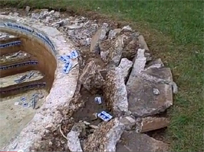installation
Skimmers are found in just about every type of watershape imaginable, including gunite, vinyl-lined, fiberglass and aboveground pools as well as in-ground and portable spas – not to mention ponds, streams and fountains. In each case, specific skimmers have been designed to serve the individual applications. For purposes of this discussion, let’s keep things simple by
Back in January 2009, WaterShapes ran a big article on the team effort involved in installing the first-generation rainwater-harvesting system developed by the folks at Aquascape (St. Charles, Ill.). Ed Beaulieu’s article (linked below) went into great detail on how everything came together, so I won’t duplicate that information here. But I feel obliged to stress the point that a
As a long-time pond installer, I have no fear when it comes to tackling large projects. In this case, a garden center in our area asked us to convert a derelict swimming pool on the property into a showpiece pond/waterfall complex the center could use to entice customers into thinking about aquatic settings and plants. We
The approach I took to this five-part series of articles on dry-stacked stone walls was a bit out of order – and I did it that way for a reason. If you’ll recall, in the last article I set aside any discussion of the drainage issues involved in stacking these walls. I did so both because it
Before I get to the meat of this series on using stone in landscapes and as part of aquatic environments, I must address an important concept having to do with how people have built with stone, both historically and in the here and now. The vast majority of stone walls and fences you see today – whether they were built 700 years ago or 70 – were
I love tile. For years, it has pushed all my creative buttons and fired my desire to learn everything I can about all of its forms. From my first days in the business to this very day, I’ve been inspired by its beauty, its rich history, the challenges involved in installing it perfectly and the potential it has to transform spaces. And it’s no stretch to say I’ve worked with tile most of my life, reaching all the way back to when I was 12 years old, mixing mud and cleaning tools for a neighbor who was at that time a prominent tile contractor in Los Angeles and Hawaii. As a teenager, I worked weekends and summers (when the surf was low), eventually picking up what I needed to know to complete installation jobs on my own. I tried a variety of other things – been in bands and played music around the world, designed sets in Hollywood, supervised a variety of construction projects, worked in a few restaurants. But I’ve always come back to tile, started my own installation business in the early 1980s and have been at it ever since. As I’ve learned more and grown in skill, I’ve come to see tile design and installation as
No matter the field, keeping up with the latest product developments is critical to supplying clients with state-of-the-art results. It’s also important to track current design and application trends and to distinguish innovations of true value from those that don’t add up or aren’t far enough along the developmental curve to warrant broad acceptance. Using my field of landscape lighting as an example, the past quarter century has seen a small clutch of products and technologies that have made the grade – the chief among them being




















